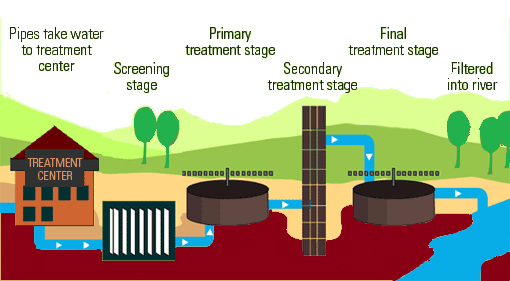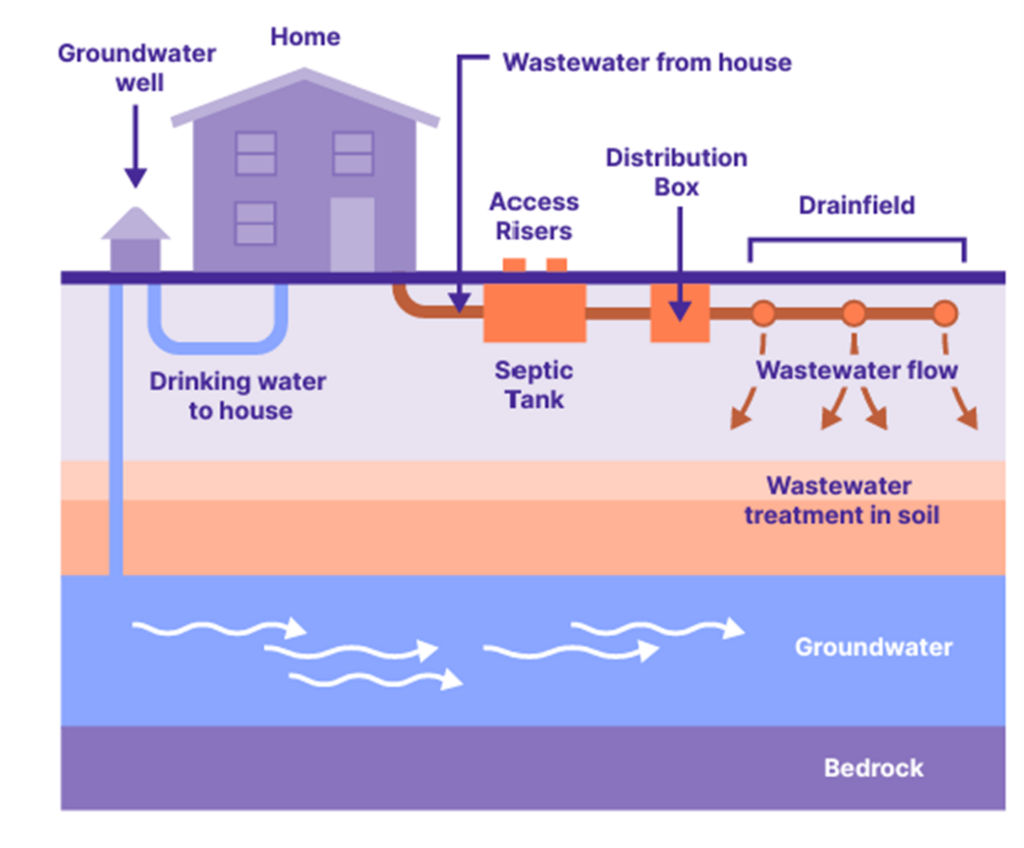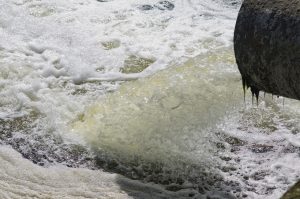Existing Treatment Systems
Managing sanitary waste has been a concern since the earliest settled civilizations. Historically, wastewater was discharged into the nearest waterways, taking advantage of dilution and oxidation as treatment. This idea of “self-purification” was not incorrect; many contaminants can be removed by natural processes with sufficient exposure, time, and dilution. However, population growth, and an increase in wastewater pollution have rendered this approach inadequate. The discovery of water-borne illnesses resulted in development of sanitation systems with the goal to separate wastewater from drinking water to protect human health. ref Many treatment systems have since been developed to decrease the amount of raw human waste entering oceans. Below is an introduction to common wastewater treatment systems used today.
Types of Wastewater Treatment Systems
Centralized Treatment Systems
Densely populated areas and industrialized cities primarily rely on centralized wastewater treatment plants to receive and treat sewage. Intricate networks of underground sewer pipes bring sewage from homes and buildings to the treatment plant using gravity and pumps. Once sewage arrives at a wastewater treatment plant, it undergoes several stages of treatment before being discharged:
- Primary, or physical, treatment begins with screening: sewage is passed through screens to remove large solids. Effluent is then brought to settling tanks where gravity helps to settle out additional suspended solids.
- Secondary, or biological, treatment aims to remove organic matter from sewage before disinfection. Oxygen and microorganisms are used to catalyze and promote biochemical reactions that break down contaminants. This process models natural systems and is made more efficient by aeration or exposure to additional oxygen. Oxygen is necessary for decomposition, and aeration helps eliminate dissolved gases. These reactions eventually encourage remaining particles to settle out. Common techniques for biological treatment include trickling filters and activated sludge, which increase the surface area available to microorganisms, as well as their density.
- Tertiary, or chemical, treatment is used to promote further settling and nutrient removal. Added polymers attract pollutants to create clumps while carbon or charcoal filters catalyze physical adsorption to reduce nutrients.
- Finally, effluent is disinfected to neutralize any remaining pathogens. While chlorine is one of the most common disinfectants, UV or ozone may be preferred to minimize residual chemical concentrations. ref

The flow of effluent through a wastewater treatment plant from intake pipes to discharge. Source: Mallik and Arefin 2018
The types of treatments used and the quality of the treated water varies based on location, water conditions, availability of treatment technology, pollution reduction goals, and other factors. Primary and secondary treatment are required in some countries and the number of facilities incorporating tertiary treatment is increasing. ref However, even where treatment is required, failures are common and it should not be assumed that regulations guarantee adequate treatment. At municipal and facility levels, there are often limitations on nutrient concentrations in effluent to address nutrient loading and the resulting eutrophication. While treatment criteria are helpful, they are not enough to protect marine ecosystems from pollution without widespread implementation of nutrient-reducing measures.
Combined Sewer Systems
In large urban cities, many landscapes lack the absorption and retention capabilities that soils, grasslands, forests, and other natural features offer. When it rains, water flows over impervious (i.e., paved) surfaces, collecting debris and contaminants and becoming polluted runoff commonly referred to as stormwater. To minimize impacts to water bodies, many cities have built combined sewer systems to collect and transport stormwater from multiple locations to the same centralized wastewater treatment plants as sewage. This allows the treatment plant to remove the oils, pesticides, bacteria, sediments, and other contaminants that stormwater contains. While a combined sewer system seems efficient, heavy storms, large snowmelt, and sometimes even light rain can exceed the capacity of these pipes, holding tanks, and treatment systems. The overburdened system discharges large amounts of untreated wastewater, including raw sewage, into waterways. In the United States, 40 million people are served by combined sewers, which discharge over 3 trillion liters of untreated sewage and stormwater runoff annually in combined sewer overflow events. ref
See this case study of work to centralize wastewater treatment on the island of Roatan, Honduras.
Decentralized Treatment Systems
Decentralized wastewater treatment systems, or non-sewered sanitation systems, are small-scale, on-site systems for managing human waste.

A conventional septic system. Source: EPA 2018
Decentralized wastewater treatment systems collect, treat, and discharge wastewater effluent at the site where it is generated. Many types of onsite treatment systems exist. The following types are the most common globally:
- Septic systems typically include a septic tank and a drain field. The tank is a buried, water-tight container usually made of concrete, fiberglass, or polyethylene. Organic matter is digested in the tank and the process separates floatable matter (e.g., oils and grease) and solids from the wastewater. The effluent is slowly discharged from the tank into a series of perforated pipes buried in a leach field, chambers, or other special units.
- Drain fields, a part of a septic system, promote opportunities for additional treatment of effluent by microorganisms in soil, gravel or other materials before discharge into the ground or surface waters.
- Cesspools have one containment and treatment step. Dug or built pits collect effluent for natural settling. The pits may be unlined or separated from soil and groundwater with a stone or concrete barrier. Cesspools do not provide adequate treatment, and are being replaced in many places by more effective treatment systems.
- Container-based systems collect and store wastewater on site and require the waste to be transported elsewhere for treatment. These systems are predominantly found in areas with limited infrastructure and include pit latrines, which need to be emptied once they are full, and bucket toilets, which are emptied daily. Treatment of waste collected from container-based options can range from conventional treatment processes, new resource recovery practices, or no treatment at all.
The video below from The Nature Conservancy Long Island provides a more detailed explanation of septic and cesspool systems.
Conventional septic systems and cesspools are not designed to remove nutrients or other contaminants from effluent, which can pose hazardous threats to marine environments in coastal areas. Technologies have recently been developed to address nutrient removal in decentralized systems, but these new solutions have not been widely implemented due to a global lack of regulation on nutrients in wastewater effluent. Upgrading decentralized systems to include enhanced nutrient reduction is costly but has demonstrated greater cost efficiency than building new, large-scale wastewater treatment facilities. Learn more about these new technologies in the Emerging Management Solutions section of this toolkit. Other disadvantages of decentralized systems include leaks and malfunctions which can result in nonpoint source pollution and often goes undetected; and few consequences for noncompliance even when pollution sources are traced, which leaves little opportunity for enforcement.
Discharge

Discharge from an outfall pipe. Photo © pixabay
After treatment from either centralized or decentralized systems, treated effluent is discharged directly to nearby water bodies or into the ground. The types of treatment applied to the wastewater and location of the discharge affect to what degree wastewater effluent pollutes the ocean. Outfall pipes discharge effluent directly into rivers and oceans. Alternatively, drain fields, soils, wetlands, and vegetation slow percolation of effluent into groundwaters, which helps to remove pollutants. This has led to the development of advanced nutrient reduction techniques and Nature-based Solutions to slow the flow of effluent. The case study from Santiago in the Dominican Republic demonstrates great success in using constructed wetlands to reduce the organic pollutants discharged to the watershed. See the Emerging Management Solutions section for more information about innovative nutrient reduction techniques and Nature-based Solutions.
Discharging inadequately treated wastewater increases hazardous risks for people, animals, and ecosystems. It is relatively easy to determine if a coastal large-scale treatment plant is discharging treated or raw effluent directly into the ocean. It is more difficult to detect leaching from smaller containment systems and groundwater discharge. See the case study from Dar es Salaam, Tanzania, East Africa for an example of how to combat the issue of pit latrine contents being dumped into the environment.
How to Select a Wastewater Management System
There are a variety of ways to manage wastewater. Selecting a wastewater treatment method is highly location and context specific. Many factors dictate which type of system is more appropriate: a sewered, centralized treatment system or an onsite, decentralized treatment system. The best solution for one community may not work for another. Considerations for selecting a wastewater management system should include:
- Community resources
- Population size
- Social and cultural norms and expectations
- Political support or regulatory constraints
- Local geology and hydrology
- Pollution reduction goals
- Existing infrastructure
When determining the most suitable sanitation system or technology for your site and context, marine managers can consult decision support tools that account for social, human health, and environmental criteria. Examples include the Sustainable Sanitation and Water Management Toolbox which helps highlight different sanitation options based on selected inputs or outputs ref and this flow diagram from WaterAid, which maps the flow of excrement from source to sea highlighting areas where management actions are working well and areas where improvement is needed.
